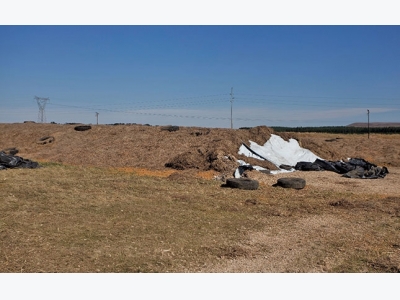Winter feeding methods: a tale of two farms

There is more to feeding in winter than simply keeping cattle alive until summer. Mistakes in winter cattle feeding may take more than one season to rectify, and costs a farmer time, money and production. Gerhard Uys assesses how two farmers tackle the challenge differently.
Silage can be stored for up to six years, is not affected by frost and takes a large part of winter feed concerns away. Photo: Gerhard Uys
Riaan Randles’s farm nestles in the mountainous eastern Free State between the towns of Memel and Harrismith. The veld is sour and dense.
Randles started in 2002 as a part-time farmer with 56 Angus cattle and subsequently resigned his Johannesburg-based job in 2012 to farm full-time, by now with 1 500 Brahman-Angus cattle on 3 000ha of land.
Rian van Wyk started farming near Panbult on the Mpumalanga Highveld in 1980 and added the Jagtdrift Brangus stud to his commercial herd in 2003.
He currently runs 520 registered Brangus females alongside 930 commercial females. Maize and soya bean are his main sources of income, although pine and eucalyptus timber contribute to diversification. The Mpumalanga escarpment’s high rainfall, sandy soil and sour veld favour a mixed farming operation.
Baling camps
Randles cuts and bales his vlei grass and Eragrostis pasture as winter feed. He cuts vlei grass rather high above the ground, leaving between 25cm and 45cm as standing hay. “I keep the cattle close to the baling camps and don’t move bales more than one kilometre,” he explains.
Randles stores the bales strategically in 10 different bale camps. With veld fire a perpetual risk, this strategy prevents his entire fodder bank from being destroyed in a single fire.
“I try to retain bales for as long as possible by feeding only cows with calves,” he explains.
“Cattle that deteriorate rapidly in condition during winter are removed from the herd and also given the bales. “It makes better economic sense to improve their condition and then sell them, rather than cull.”
Randles produces 2 000 to 2 500 bales annually and starts using them in August. Vlei grass accounts for 1 000 bales, and Eragrostis the balance.
The latter is higher in protein, which is important for condition and energy in cattle. Other grasses may be higher in protein than Eragrostis but are more difficult to manage.
When establishing Eragrostis, Randles mixes the seed with that of teff. “Teff is an annual species, while Eragrostis takes two years to reach full production.
This way, I have both species of grass in the first season and pure Eragrostis in the second. The local co-op knows what Eragrostis cultivar is suited to local conditions.
“For me, maize stover is a crucial resource. After harvesting, I put cows with three-month-old calves onto the stover. This improves their milk production and general condition. Cows on maize stover show a real difference. I keep them there until the next planting,” he explains
Có thể bạn quan tâm
Phần mềm

Phối trộn thức ăn chăn nuôi

Pha dung dịch thủy canh

Định mức cho tôm ăn

Phối trộn phân bón NPK

Xác định tỷ lệ tôm sống

Chuyển đổi đơn vị phân bón

Xác định công suất sục khí

Chuyển đổi đơn vị tôm

Tính diện tích nhà kính

Tính thể tích ao hồ



 Twinning in cattle: benefits vs cost
Twinning in cattle: benefits vs cost  5 Cattle diseases that can kill your business
5 Cattle diseases that can kill your business